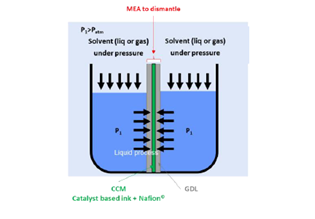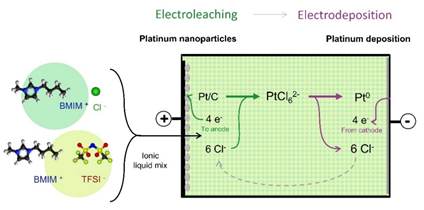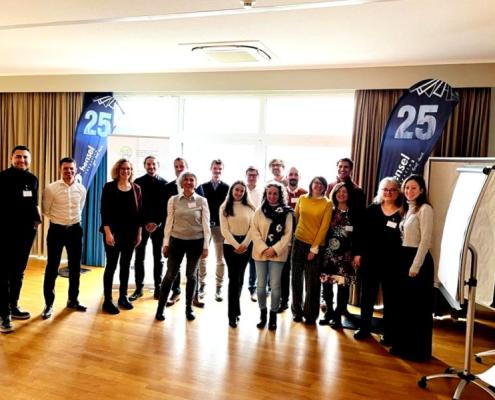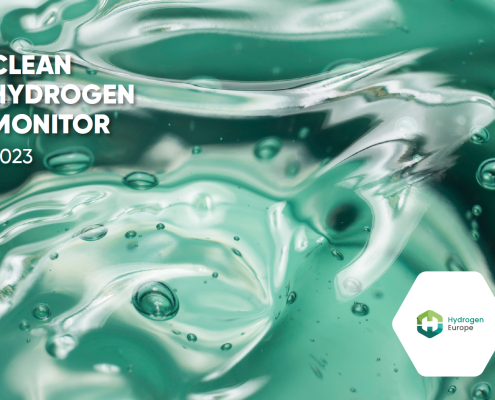Lab Scale Optimization Results for PEM Recycling
Report of first year of research on 3 PEMFC Recycling Technologies
Report of first year of research on 3 PEMFC Recycling Technologies
Report of first year of research on 3 PEMFC Recycling Technologies
One of the BEST4Hy project research activity is the identification and recovery of strategic recyclable and reusable materials and components, such as Platinum (Pt) and ionomer used in PEM (Proton Exchange Membrane) fuel cells components (catalyst and membrane). Two existing recycling technologies and a novel one have been explored by the partners Hensel Recycling, IDO-Lab and CEA with some relevant results at this first year of research.
The overall process identifies a first fuel cell disassembling step, followed by 3 possible recycling technologies identified and studied by BEST4Hy considering different goals and scenarios (Figure 1 and 2):

Figure 1 – Hensel Recycling/IDO-Lab internal processing of incoming material from EKPO

Figure 2 – CEA internal processing of incoming material from EKPO
All experiments, here reported, were performed on PEM fuel cells provided by EKPO and characterised by different stacks, cell packages, MEA type and time of operation (EoL – fresh, 200h, 2800h, 7800h).
Disassembling step aims to reduce material losses (Pt and ionomer) and make the recovery processes more efficient.
Hensel Recycling has explored the manual dismantling process for both PEM fuel cells stack and single cell, as documented by the video below:
After the manual process, different trials of mechanical disassembling took place to evaluate an industrial scalable method for future development. Following these purposes, Hensel Recycling has performed 5 trials with different mechanical technologies (see chapter 3.2 in D1.1 for more detail). Last mechanical trial #5 is a hybrid process, where manual disassembling of BPP, rubber sealants and mechanical shredding of CCM are joint.
Whereas, the gaseous phase dismantling is the novel EoL technologies performed by CEA. The goal is to separate the different components of MEA (GDL and CCM), using high pressure to force the penetration of the solvent through the GDL to reach the membrane and promoting the swelling to complete the MEA’s dismantling (Figure 3). As first step of experiment, CEA performed and optimised the process using not directly the BEST4Hy incoming material to not compromise it. Main findings are the ethanol as best solvent, easy catalyst ink recovery and a very easy GDL and CCM disassembling, other than a clean aspect for GDL and membrane.

Figure 3 – High pressure-based process
Overall, manual and gaseous phase dismantling seems to be the best processes until now and promising results are expected for the hybrid trial #5, that sums up the most efficient aspects of manual and mechanical disassembling.
After the manual and mechanical dismantling, the PEM fuel cells recovered material has been processed by IDO-Lab through a hydrometallurgical treatment (HMT) to recover Pt-salt in three main steps: leaching with aqua regia, filtration to recover ionomer and carbon particles, precipitation in solid form as (NH4)2PtCl6 after reaction with ammonium chloride and then recovered through filtration.
Then, CEA proceeded with the characterisation analysis using a thermogravimetric (TGA) spectrum: both MEA types showed similar overall yields of ~80% after the laboratory process standardization to recover Platinum as Pt-salt.
Main results have been obtained in the batch #3 and still promising results are expected with the next trials.
CEA investigates a new technology for the Pt recovery from PEMFC stacks.
The process of electro lixiviation/deposition is based on a patented process proposed by CEA and enables the recovery of platinum without the use of organic solvents nor acids, free from toxic gas emissions and convenient as it operates in only one step.
The proof of concept is showed in the figure below: the Pt nanoparticles are electrochemically leached at the anode, forming platinum and chloride complexes, and zero-valent platinum is electrochemically deposited at the cathode of the same electrochemical cell.

Figure 4 – Scheme of simplified electrochemical leaching and deposition process operating mode
The testing on a new electrochemical cell has just started, therefore next steps are the parameters optimisation for the electrochemical vessel on Pt and GDE material together with the development of an innovative anode system that enable the lixiviation of Pt from CCM. This system will be also implemented at a pilot scale to handle higher amounts of MEA material simultaneously.
It is a very important milestone the development of the ionomer recovery technique by alcohol dissolution (AD): the extreme heterogeneity of the ionomer and its complex degradation issue, the many different producers and variety of products makes it more difficult to identify the best process methodology.
IDO-Lab performed some preliminary tests so far: first test using a mixture of methanol and water (90/10) by reflux dissolution at ~50°C and a second one with ethanol/water (90/10) at 80°C. First conclusions are the identification of the ethanol as ideal solvent to perform the alcohol dissolution, high pressure and temperature (>120° C) as best performant parameters. Still some aspects need to be investigated, such as the use of autoclave and the final product centrifugation, and an internal Advisory Board member will be also involved to help the to determine the re-usability of the recovered material and add some meaningful information.
For a more complete view of the activities undertaken, have a look at the Deliverable1.1
 https://best4hy-project.eu/wp-content/uploads/2023/12/FINAL-EVENT-PIC.png
600
800
monica
https://best4hy-project.eu/wp-content/uploads/2021/04/LOGO.png
monica2023-12-20 12:59:552023-12-20 13:06:58BEST4Hy Closes the loop: final event and achievements on the End-of-life hydrogen fuel cells recycling project
https://best4hy-project.eu/wp-content/uploads/2023/12/FINAL-EVENT-PIC.png
600
800
monica
https://best4hy-project.eu/wp-content/uploads/2021/04/LOGO.png
monica2023-12-20 12:59:552023-12-20 13:06:58BEST4Hy Closes the loop: final event and achievements on the End-of-life hydrogen fuel cells recycling project https://best4hy-project.eu/wp-content/uploads/2023/12/mat-1.png
648
1152
monica
https://best4hy-project.eu/wp-content/uploads/2021/04/LOGO.png
monica2023-12-07 17:44:232023-12-07 17:54:32BEST4Hy in Mat Environnement Magazine
https://best4hy-project.eu/wp-content/uploads/2023/12/mat-1.png
648
1152
monica
https://best4hy-project.eu/wp-content/uploads/2021/04/LOGO.png
monica2023-12-07 17:44:232023-12-07 17:54:32BEST4Hy in Mat Environnement Magazine https://best4hy-project.eu/wp-content/uploads/2023/11/CleanH2Monitoring.png
993
1401
monica
https://best4hy-project.eu/wp-content/uploads/2021/04/LOGO.png
monica2023-11-22 14:57:182023-11-22 14:58:02Clean H2 Monitor 2023
https://best4hy-project.eu/wp-content/uploads/2023/11/CleanH2Monitoring.png
993
1401
monica
https://best4hy-project.eu/wp-content/uploads/2021/04/LOGO.png
monica2023-11-22 14:57:182023-11-22 14:58:02Clean H2 Monitor 2023

This project has received funding from the Fuel Cells and Hydrogen 2 Joint Undertaking (now Clean Hydrogen Partnership) under Grant Agreement No 101007216. This Joint Undertaking receives support from the European Union’s Horizon 2020 Research and Innovation program, Hydrogen Europe and Hydrogen Europe Research.
© 2022 All rights reserved. PI 07154400019 Privacy and Cookie Policy

 Recovery of materials from end-of-life Solid Oxide cells
Recovery of materials from end-of-life Solid Oxide cells